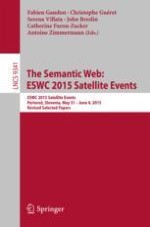2015 | Buch
The Semantic Web: ESWC 2015 Satellite Events
ESWC 2015 Satellite Events, Portorož, Slovenia, May 31 – June 4, 2015, Revised Selected Papers
herausgegeben von: Fabien Gandon, Christophe Guéret, Serena Villata, John Breslin, Catherine Faron-Zucker, Antoine Zimmermann
Verlag: Springer International Publishing
Buchreihe : Lecture Notes in Computer Science
